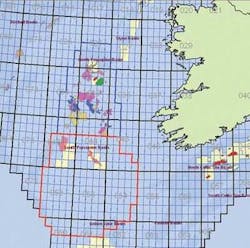Andrew Vinall, Jim Hannon, Hannon Westwood LLP
Exploration offshore Ireland never has experienced the same level of interest as off the UK or Norway, despite similarities in the geology, a stable political environment, and a benign tax regime.
With fewer than 160 wells drilled to date on the Irish continental shelf, the province is, apart from offshore France and Germany, the most under-drilled in northwest Europe. However, new studies and a high profile licensing round offshore the Porcupine basin are changing perceptions about Ireland’s prospectivity.
For the past two years, the Petroleum Affairs Division (PAD) of the Department of Communications and Natural Resources in the Irish government has been promoting activity offshore Ireland, particularly the Atlantic side, at industry conferences in Europe and the US. The intent has been to stimulate interest in the 2005 Slyne, Erris, and Donegal basins licensing round and the proposed 2007 Porcupine basin round.
The government has commissioned numerous studies of the area’s unrealized potential. Much of this work has taken into account the pre-break up palaeogeography of the North Atlantic region as a whole, leading to a better understanding of the geology of the region.
Numerous factors could make the forthcoming Porcupine basin round one of Ireland’s most successful to date. These factors include the increase in oil prices over the past few years, the significant and growing deficit in domestic gas production, some encouraging gas discoveries in the Slyne, Donegal, and Celtic Sea basins, and the paucity of licensing rounds elsewhere at present in northwest Europe.
Frontier drilling
Very little of the North Atlantic part of the Irish continental shelf has ever been under license, and statistics for the area underline the low level of exploration to date. The first Atlantic licenses were awarded in 1975, and up until 1995, the extent of license coverage had been restricted largely to the northern part of the Porcupine basin. This amounted to 55 blocks under license, with around 30 awarded in the Slyne and Erris basins: this is the equivalent of less than three UKCS North Sea quadrants. The first South East Rockall basin licenses were awarded in 1997, and the first Donegal basin licenses in 2005. Only 47 exploration and appraisal wells have been drilled in the area, 30 of them in 21 blocks in the north Porcupine basin. Of the Atlantic Province wells, 24 wells recorded hydrocarbon shows, with at least 10 discovering or successfully appraising five accumulations: Burren, Connemara, Corrib, Dooish, and Spanish Point.
These discoveries lie within the Mesozoic and Palaeozoic, and with reservoirs from the Carboniferous through to the Lower Cretaceous. As yet, no discoveries have been made in the Tertiary play, though a number of wells encountered shows, suggesting that hydrocarbons can and have migrated into the Tertiary. As a recognized frontier province, few of the wells have been drilled with the benefit of 3D seismic.
Work completed in the past year by Hannon Westwood, in association with the PAD, on the historically licensed acreage in the Atlantic province has revealed around 190 undrilled prospects and leads, ranging in age from Carboniferous to Tertiary, and covering a range of structural and stratigraphic trap styles. Some of these prospects are in the super-giant field category, such as the Dunquin structure recognized by Irish independent company Providence, which also attracted ExxonMobil back into Ireland after a gap of more than 10 years. Others are much more modest, such as the Connemara discovery, with estimated oil reserves of 73 MMbbl, which currently is undergoing detailed reservoir engineering and development optimization to determine commerciality.
A Hannon Westwood study has highlighted that there is an un-risked, yet-to-find potential of 35 Bboe in the Atlantic Province, based on known prospects and leads, of which some 18.5 Bboe are in the Porcupine basin. This undrilled potential is similar to the yet-to-find potential for the Atlantic Margin areas of the UKCS and Norway.
Although activity has been relatively slow for the last two years, with no wells being drilled offshore Ireland in 2005, there is now a progressive increase in activity, particularly in the Celtic Sea basin where about four wells are to be drilled this year. One of these wells has appraised the Old Head of Kinsale gas discovery made in 2006, the first new gas find for 16 years. Commercial activity is also on the rise, with several farm-ins to Celtic Sea licenses announced this year. Most recently, Hess farmed in to two of Shell and Statoil’s licenses in the Slyne-Erris basin, with the promise of new seismic acquisition and the drilling of a well in 2008.
The whole of the Porcupine basin will be available for licensing when the round is opened, probably in September. The last time acreage was available in the Porcupine basin was 2004, when three licenses were awarded covering 11 blocks and part-blocks. These included acreage containing the Connemara, Burren, and Spanish Point discoveries and the Dunquin prospect.
With a better understanding of the geology of the basin, the Irish government now is looking for a greater uptake of the acreage available in 2007.




